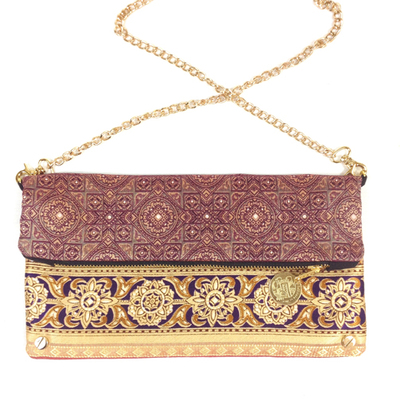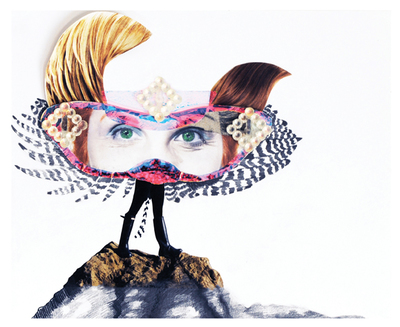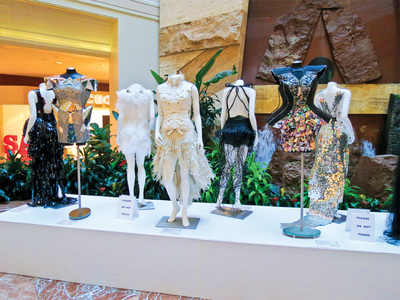FASHION FOREFRONT
WHEN “CRAFT THE LEATHER” selected RISD designer Diana Wagner as one of nine students sponsored to travel through Tuscany to learn about vegetable tanned leather from local craftspeople, artisans and tanners, her poeticism came to life. She used the trip as an opportunity to research wearability through experimentation with materials and language.

Azra Akšamija, Nomadic Mosque, 2005, textile, photographs and single-channel video (3 min.), dimensions variable. Photo: © Azra Akšamija and Jörg Mohr 2005.
Shaking the term “wear” from its most conventional use, as in “to cover, adorn or protect one’s body,” Wagner analyzed how materials “ware” over time and “where” a design might travel. Vegetable tanned leather became her canvas, and the shoe her architectural form for designs to activate patterns found in nature. By layering powdered metals with chemical reactants, she found that one-of-a-kind organic patinas slowly emerged. Wagner’s designs let the materials do the talking. As prototypes that respond to the commercial demand for objects that appear antique, her market-savvy shoes describe a new generation of designers that are part artist, part scientist and part entrepreneur.
A bevy of artists who create Wearable Art coming out of New England’s top art institutions—Massachusetts College of Art and Design (MassArt), Massachusetts Institute of Technology (MIT), Rhode Island School of Design (RISD), and Yale University School of Art—suggests that this generation of makers thinks across disciplines and mediums.

LALLITARA by Bijal Shah, Elephant XL crossbody clutch, 2014, reclaimed sari fabric, deadstock canvas, chicago screws, ykk zipper, and brass chain, 10½ x 6″ (when folded) or 8½” (when flat). Photo: LALLITARA
These institutions accommodate their students by developing lithe curricula. Wagner credits a course on Responsive Apparel for prompting her to recast deterioration and decay in a positive light—as catalysts for a material’s fullest aesthetic expression.
No doubt professors Michael Lye (who pioneers a collaboration between NASA and RISD), and Donna Gustavsen (who initiated partnerships with GAP and ELLE magazine, along with interdepartment collaborations) helped Wagner transition from a sculptor to an artist of wearable, functional designs. Wagner realized, “If I could learn how to make shoes from scratch I’d be a better designer.” Thereafter, RISD facilitated Wagner’s independent study with Brooklyn-based shoemaker Anne Marika Verploegh Chasse, who was hired to teach a course on shoemaking this spring.
The impact of Sissi Westerberg similarly manifests in the designs of her RISD Jewelry Design and Metalsmithing students. Westerberg challenges students to make Wearable Art that upsets the conventions that society assigns to bodies and jewelry forms. For her own multimedia installation, I am open, 2011, she manufactured fleshy nubs of silicone that, when worn over the hands and head, symbolically obliterate the wearer’s intellectual qualities. Her work transforms the representation of the body, traditionally emblematic of measured reason, into an uncanny inside-out labyrinthine orifice. “The work asks, how can the body become even more of a body than it is?”
Kamal Nassif (RISD JM ‘14) makes Wearable Art that likewise challenges the conventional logic of success in jewelry design. Fascinated with human desire and its link to gender, her work explores evolving perceptions of womanhood, the male gaze and the fluctuation between cliché and the absurd. The Importance of Beauty and The Body Hair Is Unsightly Factors: A Book, 2013 (Nassif’s grammatical error is intentional), emerged from a seminar she took with Westerberg, following the assignment to create a body extension. Nassif’s “book” opens to reveal a velvet-lined cosmetic kit. It holds a makeup brush, scissors, a circular adhesive strip and a lock of hair. A diagram shows the user how to wear the hair under the armpit. While Nassif readily admits that no one has worn the design outside of the studio, she emphasizes its connection to her more conventional works. Her striking red-lip steel pin and stately pearl necklace, reimagined with opulent breast-shaped beads, are available by inquiry through her website.
Nassif’s take on selling her designs is as politically sophisticated as her practice. “I see no reason not to capitalize on the thinking behind conceptual work,” she says, unswayed by ideological trappings of a Marxist critique. Like W.A.G.E., a New York-based activist group that advocates for the regular payment of artist fees, Nassif defends her right to be paid for services rendered.

Laura Marsh, Cat Eye Glance, 2013, belt loops and collaged imagery, 17 x 20″ framed.
At MIT, two business students at the Sloan School of Management enrolled in Azra Akšamija’s course, Fabrics of Cultures: Art Fashion, Identity, offered through the masters program in art, culture and technology. Akšamija asked students to create a wearable design that expressed a political and cultural conflict that the wearer otherwise could not address. Aminata Kane, founder of Fula & Style, an urban-chic clothing company based in Senegal, designed a garment that asked, “Does African fashion need to be ‘ethnic’ to be identified as such?” Bijal Shah, founder of lallitara, a startup that buys and repurposes secondhand saris from India’s sari-pickers, responded by sewing together a dress made of saris that was then passed around the United States for one-time wear. Both Kane and Shah’s companies source labor from the communities they operate within, showing how the making of Wearable Art has the potential to realign modes of production, sustainability and entrepreneurship.
Akšamija applauds MIT’s program that allows graduate and undergraduate students from other academic concentrations to encounter one another in a classroom become laboratory. MIT has led her to discover how wearable design opens up new possibilities for storytelling: “The school teaches its students to be problem solvers and my class helps students use a different part of the brain. Rather than focus on finding one answer we dilate the problem and think about it anew.”
Akšamija starts with a problem in her own work. For her ongoing Wearable Mosques Project, she uses clothing and textiles to ask how one might address the religious conflict surrounding Islam in post 9/11 America. Nomadic Mosque, 2005, draws from a Western-style contemporary female business suit with a hood that unfolds into a space for prayer. Survival Mosque, 2005, adapts the concept of concealment to include self-protection. The work features an American flag façade, situating patriotism as a strategy for camouflage. She explains, “Both are designed to suit the individual needs of the worshipper and in practice recognize the need for the youthful Islamic community at MIT to speak out against prejudice.”

MassArt Wearable Art show, l. to r. Alyssa Fishenden, VHS tape dress; Sarah Buxton, mirror board, chipboard, and candlewick taps dress; Christian Restrepo, turkey and duck feathers, painted potpourri dress; Gloria Im, mini blinds dress; Sierra Chew-Chin, twist tie dress; Marsha Titova, electric cord, CD, computer chip, LED lights, and electrominescent LED cord dress; Kimberly Nowers, mirrored tile dress. Photo: James Mason.
Yale alumna Laura Marsh (MFA Sculpture, ’09), who has made New Haven her home base, takes camouflage in a different direction. Her oversized United Glasses of America, 2013, are embossed with fake pearls, gold studs, sequins, and white fur. Feigning luxury status, the glasses revel in the affective properties of their flashy design. On the first day of Introduction to the Cultural History of Things, American Studies Department professor Kariann Akemi Yokota had everyone empty their workbags. “She explained we are all influenced by the materials that are marketed to us,” Marsh recalls, and “I had cut fabric.” Part of Marsh’s reason for being in the course was Sculpture Department Director Jessica Stockholder, who insisted that students take classes outside the department. Her own interest in making Wearable Art for performance led to a course in Costume Construction, offered through the Yale School of Drama. Ironically, outside her program, Marsh learned how to use sewing machines and craft functional designs.
At MassArt, the Fashion Design curriculum prioritizes technical proficiency. Associate Professor Jayne Avery explains, “We teach students all aspects of marketing, wearability and function as well as the skills needed to produce work in the real market.” The annual non-textile Runway Show, a requirement for sophomores, exemplifies the program’s focus on function and form. Even non-textile works, which come closest to the concept of Wearable Art, must: (1) fit the body, and (2) not harm the model. This year’s designs included dresses made of film, window blinds, hair, computer parts and twist ties. “They don’t need to be comfortable,” Avery adds with a wink, but the constructions must be impeccable, since MassArt has arranged to exhibit them on the bustling floor of Boston’s Copley Place Mall following their debut.
The four universities have facilitated a technical and conceptual overlap between art and science, resulting in an array of innovative Wearable Art and design. However, this approach is hardly new. MIT was founded in 1860, MassArt in 1863, the Yale School of Art in 1869 and RISD in 1877, following the influence of businessmen who made fortunes in the China Trade, textile manufacturing, railroads and retailing, and pushed for state sponsorship of institutions that would ensure their industry’s long-term development. MIT’s founding pamphlet penned by geologist, physicist and educator William Barton Rogers in 1860 sheds light on his prescient vision for a three-part institution to include a Society of Arts, a Museum of Arts, and a School of Industrial Sciences. Addressed to “manufacturers, merchants, mechanics, agriculturalists and other friends of enlightened industry in the Commonwealth,” Rogers writes, “…It would be the object to provide a substantial and continuous course of teaching, while imparting a knowledge of the principles, facts and processes connected with the Arts, [and] should cultivate the habits of observation and exact thought, which are so conducive to the progress of invention and the development of intelligent industry.”
Sarah Fritchey is a freelance writer and curator based in New Haven. Recent projects include reviews for artforum.com.
